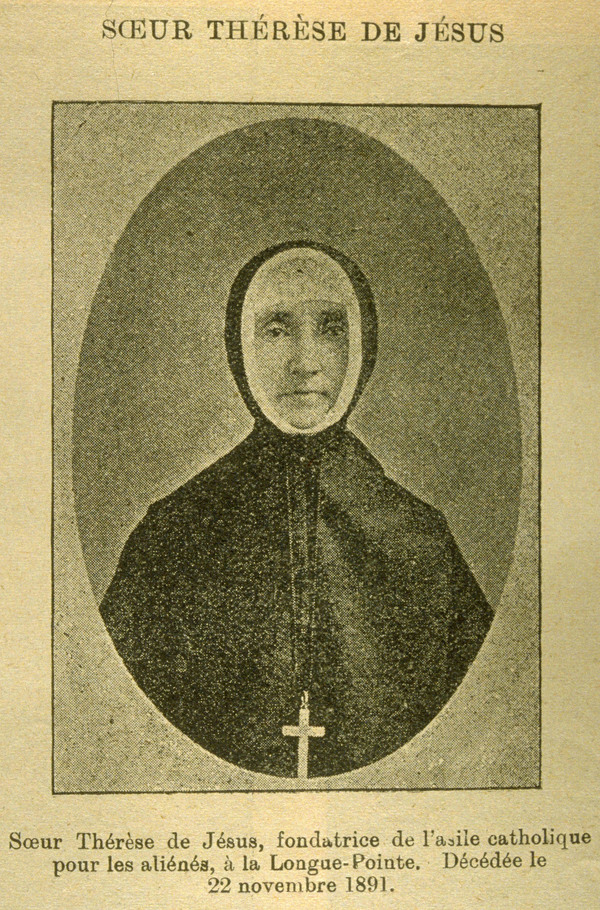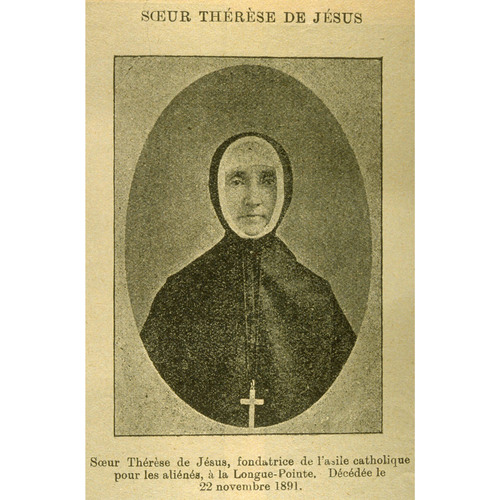
Source: Link
TÊTU, CLÉOPHÉE (baptized Françoise-Cléophée), named Thérèse de Jésus, Sister of Charity of Providence (Sister of Providence); b. 3 Dec. 1824 in Saint-Hyacinthe, Lower Canada, daughter of Jean-François Têtu and Cécile Chabot; d. 22 Nov. 1891 in Longue-Pointe (Montreal).
Cléophée Têtu’s father was a notary at Saint-Hyacinthe, where he was also the seigneurial agent for Jean Dessaulles*. He took enough of a part in the rebellions of 1837 and 1838 to spend several months thereafter in exile in the United States and to be imprisoned for two months on his return. Cléophée received a sound Christian education from the sisters of the Congregation of Notre-Dame in Saint-Hyacinthe. On 5 Oct. 1844 she joined the Daughters of Charity, Servants of the Poor, a community founded the preceding year in Montreal by Emilie Tavernier* and later known as the Sisters of Charity of Providence. The young novice was privileged to know the foundress and to experience the heroic beginnings of the institute. On 21 July 1846 she took her vows and assumed the name Sister Thérèse de Jésus.
Her talents as a leader and organizer were quickly recognized. In 1849 she became the officer in charge of the sick at the Hospice Saint-Camille. In August of that year she was appointed superior of the Hospice Saint-Jérôme-Émilien, an institution for the education and care of orphans. She was next assigned to important tasks abroad. In 1854 she founded St Joseph’s orphanage in Burlington, Vt, and became its director. After she had devoted three years to this post, a still greater challenge awaited her: work in Chile as a missionary, first in Santiago, and the following year in Valparaiso where she held a supervisory post. By 1863 she had put the establishments entrusted to her in Chile on a sound basis, and she returned to the mother house in Montreal.
Sister Thérèse de Jésus spent several months visiting the poor and the sick before being reappointed superior of St Joseph’s orphanage in Burlington. Three years later she returned to Montreal, where her wide experience led to her serving the community as bursar general from 1866 to 1875. In this capacity she had the responsibility of visiting various insane asylums in the United States and Ontario to study their operation.
The community’s work with the insane had been initiated by Emilie Tavernier in 1845. After her death in 1851, the congregation provided care for such patients in scattered premises of varying suitability. It was imperative to put up a central building for these services. Sister Thérèse de Jésus supervised the construction. Inspired by Mount Hope Retreat Hospital in Baltimore, Md, the Asile de Longue-Pointe (subsequently called the Hôpital Saint-Jean-de-Dieu and then the Hôpital Louis-H. LaFontaine) was inaugurated on 6 Aug. 1875. Sister Thérèse de Jésus was named its superior, and 408 patients were admitted in the first year. Running the hospital at that time, when the government paid only $100 per patient per year, required unusual administrative skill. Anxious to offer the highest possible level of care, she spent two months in Europe in the summer of 1889 visiting some 40 of the most highly reputed facilities for the care of the insane, accompanied by one of the other sisters, a lawyer, and two of the hospital’s doctors.
In May 1890 Sister Thérèse de Jésus, suffering from influenza, had to face the most terrible trial of her life: in the space of a few hours she saw the hospital that she had given 15 years to building go up in flames. The fire killed 80 people and left 1,200 patients without shelter. She summoned up the strength to direct the necessary emergency measures and then to see that temporary wings were fitted out with sufficient equipment. After three months of intense work the hospital was again ready to admit patients.
Sister Thérèse de Jésus died a short time later, on 22 Nov. 1891. Both English and French newspapers in Montreal published obituaries full of praise. L’Étendard wrote: “Her heart, blessed with great sensitivity, was given entirely to the poor lunatics. . . . Sixteen hundred people at Saint-Jean-de-Dieu are in tears. In her every patient had a mother. She knew every one of them and could find a kind word for each.” La Patrie declared: “One of the great figures on our public scene has departed.” According to the Montreal Daily Star, “She was an accomplished diplomate and tactician, and in her many relations with the Government and politicians she rarely ever came out second. . . . Apart from being the first among all the women with whom her life was spent, she was even recognized as a master mind by all.”
Mgr Henri Têtu, who had known Sister Thérèse de Jésus, noted that she was “tall, slender, dark-complexioned, with black, intelligent and piercing eyes. . . . She had . . . all the qualities of one of the good Lord’s ants, and . . . a generous and deep mind, a veritable genius for organization and administration.” This remarkable religious, who spoke three languages and possessed acknowledged gifts as an administrator, was one of the most eminent career women of her time.
Cléophée Têtu, named Sister Thérèse de Jésus, and her colleague Sister Madeleine du Sacré-Cœur [Madeleine Desjardins] described their trip in Récit de voyage d’Europe . . . 1889 (s.l.n.d.).
ANQ-M, CE2-5, 3 déc. 1824. Arch. des Sœurs de la Charité de la Providence (Montréal), Chroniques de l’hospice Saint-Jean-de-Dieu à Longue-Pointe; Spécilège II: 170–75. L’Étendard (Montréal), 23 nov. 1891. Montreal Daily Star, 23 Nov. 1891. La Patrie, 23 nov. 1891. Biographies des premiers supérieurs et bienfaiteurs de l’institut des Sœurs de Charité de la Providence . . . (3v., Montréal, 1885–1903). Ægidius Fauteux, Patriotes de 1837–1838 (Montréal, 1950). Adolphe Bellay, Hospice St-Jean-de-Dieu, asile de la Longue-Pointe (Montréal, 1892). [M.-J.-L. Blanchard, dite mère Marie-Antoinette], L’Institut de la Providence: histoire des Filles de la charité servantes des pauvres, dites Sœurs de la Providence (6v., Montréal, 1925–40), 4. Henri Têtu, Histoire des familles Têtu, Bonenfant, Dionne et Perreault (Québec, 1898).
Cite This Article
Huguette Lapointe-Roy, “TÊTU, CLÉOPHÉE (baptized Françoise-Cléophée), named Thérèse de Jésus,” in Dictionary of Canadian Biography, vol. 12, University of Toronto/Université Laval, 2003–, accessed December 16, 2025, https://www.biographi.ca/en/bio/tetu_cleophee_12E.html.
The citation above shows the format for footnotes and endnotes according to the Chicago manual of style (16th edition). Information to be used in other citation formats:
| Permalink: | https://www.biographi.ca/en/bio/tetu_cleophee_12E.html |
| Author of Article: | Huguette Lapointe-Roy |
| Title of Article: | TÊTU, CLÉOPHÉE (baptized Françoise-Cléophée), named Thérèse de Jésus |
| Publication Name: | Dictionary of Canadian Biography, vol. 12 |
| Publisher: | University of Toronto/Université Laval |
| Year of publication: | 1990 |
| Year of revision: | 1990 |
| Access Date: | December 16, 2025 |



